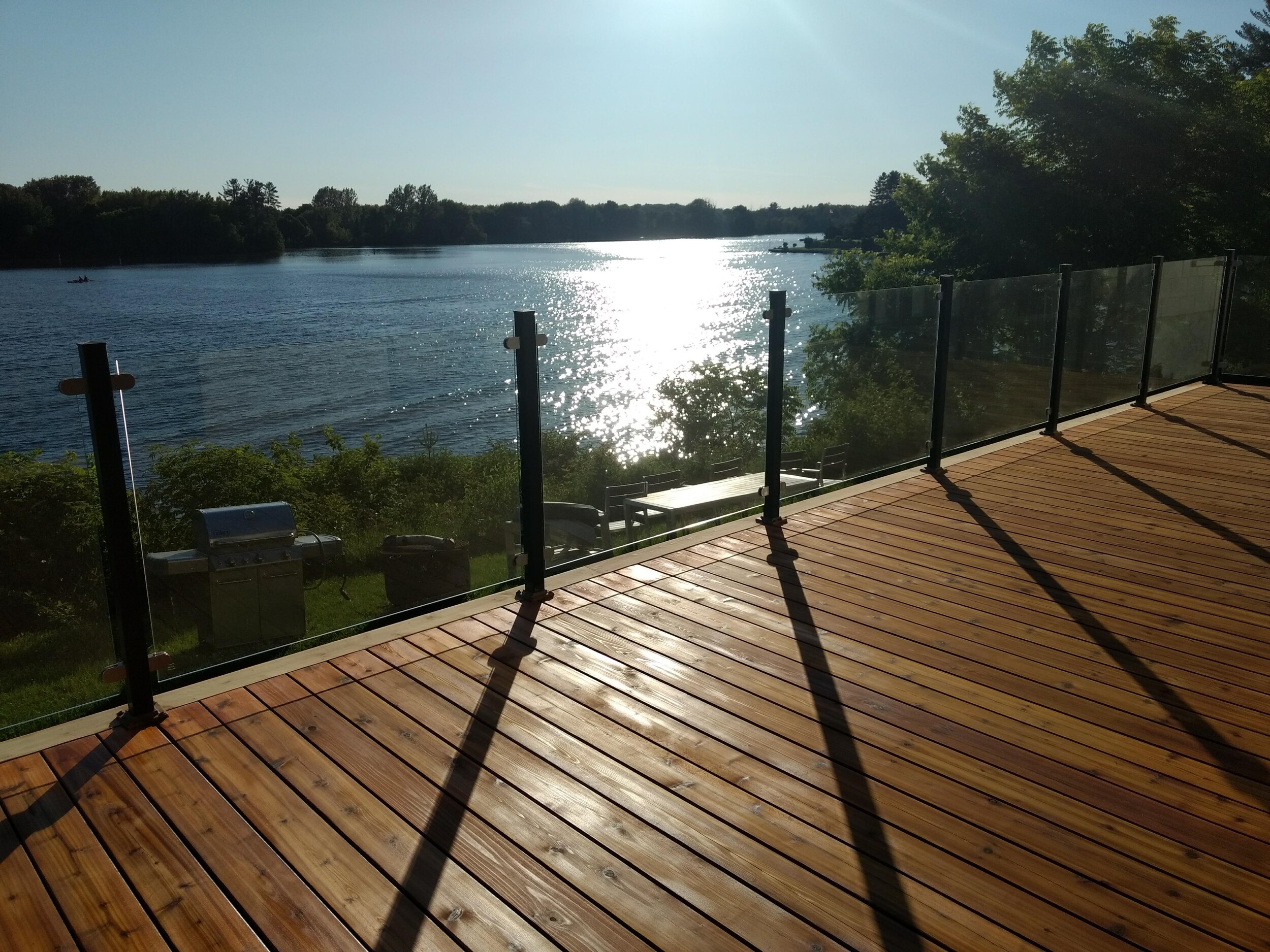
Frequently Asked Questions
Some common questions answered—check out our blog for longer posts & articles.
Why does my deck peel every year?
The two biggest reasons a deck peels are:
1) inadequate (or zero) prep work
The most common reason a deck fails is the prep work is not done properly-- if at all. Wood needs to be sanded for the stain to penetrate deep into the pores so it isn’t sitting on top of the wood like a paint. When using an oil based stain, the wood needs to fully dry before applying stain.
Wait a few days after rain before applying and try to avoid staining too early or late in the season. Use a less-is-more attitude when applying penetrating oil stains and refrain from applying thick layers or several coats at once.
2) poor quality product
Film forming stains, clear top coats, and most water based or hybrid stains are designed to form a layer on top of the wood. This layer may protect for some time, but eventually peels, blisters, cracks and needs to be stripped before anything else can be done.
We recommend using true penetrating oil stains that are transparent / translucent that can be re-coated for years before needing to be sanded again (if ever.) Avoid all opaque / solid water based stains and thicker semi-solid or semi-transparent to prevent peeling. Even hybrid stains have issues lasting over the winter or if applied in too many layers or in the direct sun.
When have I sanded enough?
It’s important to sand right back down to bare wood to be rid of any old top coats, thick stain, or even mill sheen for brand new wood. This crucial step allows the best in quality wood protection, as well as the absolute best in aesthetic finish. The sanding is the most important part of the job and what allows us to stand apart from the competition like painting companies and general contractors. We provide one service, and we do it the best.
What’s the difference between painting and staining?
Painting protects with an accumulation of layers on top of a surface, whereas a true stain soaks into the wood and leaves no films or top layer on the surface after penetrating. We always recommend finishing exterior wood with a translucent stain formula as opposed to painting it—not only for the rich reveal of natural grain patterns, but it is infinitely easier to maintain over time. Once a surface is painted, it is very difficult, timely, and expensive to retrieve the authentic bare wood before being able to apply a transparent stain.
Why use an oil-based stain?
We believe that a true penetrating oil stain is a superior product to water-based stain. With oil stains, only one coat is needed at a time as the wood becomes saturated and does not need top layers as it protects the wood from inside out from oil lubrication. If you really want two coats, it is safe to coat once the spring/early summer and once again in late summer or fall to get the most protection out of the penetrating technology.
Water-based stains typically need two coats which tend to peel because they protect more like a paint by leaving film forming top layers which blister and crack over time. In the winter months, this water-based stain freezes and expands creating cracks in your wood and of course, peels off.
How long will a stain job last?
If a deck is poorly prepped or a poor product is used, it will typically fail within the first year. This is commonly noticed in the spring after its first winter snow melt if it didn't peel before then.
Our system promises that your deck will never peel, however, it will fade quickly if not re-coated as needed. You'll want to re-coat using the same penetrating oil stain every year (one coat per reapplication) or perhaps every 2 years if deck or porch is covered or hidden from the elements, experiences little wear-and-tear, etc.
It’s recommended to use cleaner and brightener for the deck floor before re-coating to maintain the rich look of freshly oil stained wood, although a true penetrating oil stain will still properly soak into the wood if you are more concerned with protection and less concerned with aesthetics.
Should I apply using a brush, sprayer, roller, or rag when staining?
There are a few methods that are safe to use when applying penetrating oil stains.
Brush
Brushing works well—specifically a fat brush called a staining block that is designed to hold a large amount of stain so you can glide the bristles for longer without needing to reload as often. Always brush along the grains of the wood and always finish full boards if you need to stop for any reason, or the stain will leave overlap marks if you wait too long before continuing.
Manually press the stain into the open pores of the wood and spread thinly to avoiding pooling without missing any spots. The oil should still soak in if too thick, however, it could leave a sheen making it inconsistent if left too thick.
Lastly, you will likely need a staining block brush to cut along house, smooth drip marks, etc, so you would likely have to have a brush handy regardless which application method you choose.
Roller
Rollers tend to leave overlap marks which leave an extremely unpleasant sight when dried. Also, if moving too quickly with a roller, drips can make a mess and get on house siding, patio stones, etc. It is still possible with a roller, but not recommended as it if more difficult to control with higher chances of leaving a mess.
Sprayer
Spraying may save some time but could leave a mess with over spray if not careful. If using a sprayer, you would need to backbrush any excess stain to get rid of drip marks and pooling. Sprayers might be easier to control messes on fences or log homes with windows taped off. With decks, you may need to do a few boards at a time (3-4) so you have enough room to reach with a brush to smooth out any pooling. Contractors may have sprayers they are trained on, but many do-it-yourselfer’s don’t have sprayers and don’t need them.
Rag
Rags are commonly used for viscous penetrating oils typically used for hardwoods such as Ipe, or specialty heat modified products like Thermory Ash. The method is normally to apply the stain and let penetrate for roughly 30 minutes and then remove the excess with a rag to thwart stickiness, patches of shiny areas, or unevenness in general. Rags also work as a way to buff off excess stain in case of pooling or areas that are applied for thinner stains as well.
NOTE: Be careful to properly dispose of your rags as they may spontaneously combust with certain ingredients such as linseed oil. Oily rags should be soaked with water and placed into a metal container with water capped with a lid allowing no air to get in.
Lambskin Floor Pad
Lambskin blocks can be used to push the stain and using the wood block to push the stain directly into the wood. This is a fast way to coat the deck, although we recommend this method reapplications as it has a tough time getting in between the wood boards whereas a brush can reach inside with its long bristles.
